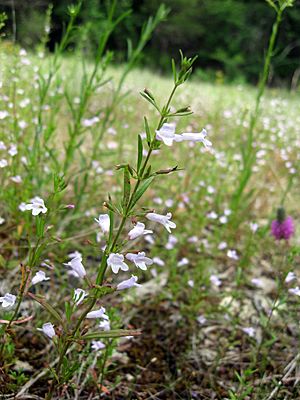Glade calamint facts for kids
Quick facts for kids Glade calamint |
|
|---|---|
 |
|
| Conservation status | |
| Scientific classification | |
| Genus: |
Clinopodium
|
| Species: |
glabellum
|
The glade calamint, also known by its scientific name Clinopodium glabellum, is a type of flowering plant. It belongs to the mint family, just like the mint you might use in chewing gum! This special plant grows naturally in only a few places in the United States. It is considered a vulnerable species, meaning it needs our help to protect its homes.
Contents
About the Glade Calamint
Where Does It Grow?
The glade calamint is native to a few specific areas. You can find it in the Nashville Basin of Tennessee. It also grows in the Bluegrass Region of Kentucky. Plus, it lives in two counties in Alabama.
This plant is quite picky about where it lives. It loves wet cedar glades. These are open, rocky areas where cedar trees grow. It also likes to grow in wet spots along limestone creekbeds. These are places where water seeps out of the ground near streams. Because it needs such special places to grow, it doesn't spread very far.
What Does It Look Like?
The glade calamint is a small plant. It is a perennial, which means it lives for more than two years. Often, it starts to flower in its very first year!
When it blooms, it produces pretty pale pink flowers. You can usually see these flowers in the late spring.
Why Is It Special?
The glade calamint is considered a vulnerable species. This means it is at risk of disappearing. It's vulnerable for a few reasons:
- It grows in a very small area.
- It needs very specific wet habitats.
Because of these reasons, it's important to protect the places where this plant grows.
A Case of Mistaken Identity
For a while, people sometimes confused Clinopodium glabellum with another plant called Clinopodium arkansanum. This made it tricky to know exactly where each plant grew.
Sometimes, Clinopodium glabellum was even called "Ozark calamint." However, this name was misleading. It turns out that the plants found in the Ozark Mountains are actually Clinopodium arkansanum, not Clinopodium glabellum. Scientists have worked hard to tell these two similar plants apart!


